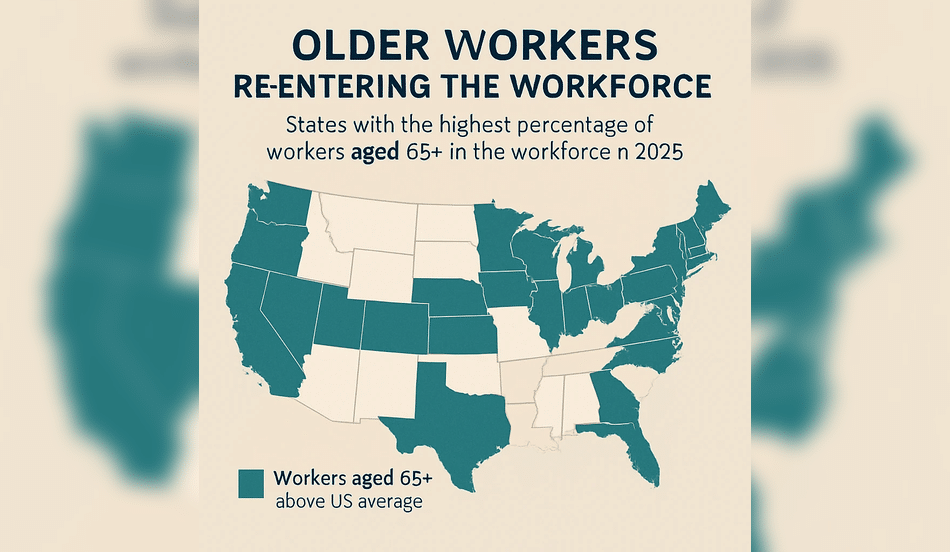Across America, a growing number of older adults are rejoining the workforce in 2025. From returning to full-time roles to picking up flexible side gigs, retirees and near-retirees are reversing decades-long trends of early exits from the labor market.
Is this resurgence among older workers driven by financial necessity, a desire for personal fulfillment, or a changing economic reality that welcomes age diversity?
The answer, as it turns out, is complex—and increasingly vital for employers, policymakers, and job seekers alike.
The Numbers: Older Worker Participation Is Rising
According to the U.S. Bureau of Labor Statistics, labor force participation among Americans aged 65 and over reached 21.4% in 2025, up from 19.3% in 2020. Among those aged 55 to 64, participation stands at 66.8%—close to pre-pandemic levels.
Industries seeing the biggest uptick in older hires include:
- Healthcare and personal care
- Education and tutoring
- Retail and customer service
- Consulting and professional services
- Remote administrative and support roles

What’s Driving the Return?
1. Inflation and Financial Pressure
Many older Americans are feeling the squeeze of prolonged inflation, especially those on fixed incomes. Rising costs for essentials like housing, healthcare, and food have prompted retirees to return to work sooner—or for longer—than planned.
“I thought I was set when I retired in 2020. But inflation and medical bills changed that,” says Robert Dean, 68, who now works part-time as a pharmacy technician. According to an AARP survey, 57% of working seniors cite financial necessity as their primary motivation for re-entering the labor market.
2. Longer Lifespans and Better Health
With advancements in healthcare and lifestyle, many older adults feel physically and mentally fit well into their 70s. Staying engaged through work is often seen as a path to maintaining cognitive function and social connection.
3. Desire for Purpose and Engagement
Work provides structure, identity, and purpose. Many older professionals—especially those who retired during the pandemic—have found retirement to be isolating or unfulfilling.
“I missed the camaraderie, the collaboration. I didn’t realize how much my work life gave me until it was gone,” says Carla Williams, a 62-year-old returning marketing consultant.
Industries Welcoming Older Talent
Some sectors are actively recruiting mature professionals due to labor shortages, customer alignment, or a need for mentorship.
Top industries for older workers:
- Healthcare: From patient transport to medical records coordination
- Education: Substitute teaching, tutoring, and academic advising
- Retail: Customer service roles align with communication and reliability
- Professional Services: Legal, HR, and consulting roles benefit from experience
- Gig Economy: Flexible work like rideshare, caregiving, or seasonal delivery
🚀 Explore Top Jobs on WhatJobs
Explore rewarding roles for experienced workers returning to the workforce where opportunity meets purpose.
External Source: Hiring Trends for Workers Over 55
The Benefits for Employers
Companies embracing multigenerational workforces are reaping rewards in productivity and culture. Older workers bring:
- Institutional knowledge and mentorship
- Strong work ethic and dependability
- Customer service skills and emotional intelligence
- Lower turnover rates in part-time roles
“Older workers are some of our most dependable team members,” says Helen Tran, HR Director at a regional healthcare provider. “Their presence stabilizes the team and enriches intergenerational learning.”
External Source: SHRM – Older Workers Add Value to the Workforce
Challenges They Still Face
Despite the resurgence, older workers often encounter hurdles such as:
- Age bias in hiring
- Digital skill gaps
- Physically demanding roles with inflexible schedules
- Healthcare coverage concerns for those under Medicare age
Organizations like AARP and National Council on Aging now offer job boards, resume support, and digital literacy training specifically for older job seekers.
A Shift Toward Age-Inclusive Employment
The return of older Americans to the workforce isn’t just an economic trend—it’s a demographic reality. As people live longer, healthier lives and seek meaning beyond retirement, the workforce is becoming more age-diverse than ever.
For employers, this represents an opportunity to reimagine talent strategy, break down age-based bias, and tap into one of the most underutilized labor pools in America.
For job search resources, upskilling tools, and the latest hiring news, visit WhatJobs News
FAQs
Q: Is this trend driven more by financial pressure or opportunity?
A: Both. While many older workers are returning due to rising living costs, others are doing so by choice—to stay active, engaged, or pursue passion-based work.
Q: Are companies open to hiring seniors?
A: Increasingly, yes. Employers in retail, healthcare, education, and consulting sectors are actively recruiting older talent due to labor shortages and customer experience benefits.
Q: What are good jobs for seniors re-entering the workforce?
A: Flexible, low-impact roles like tutoring, admin support, consulting, caregiving, and remote customer service are popular and accessible.
Q: How can older workers compete in a digital-first job market?
A: Upskilling through free online tools, mentorship, and embracing remote work platforms can help older professionals remain competitive.




